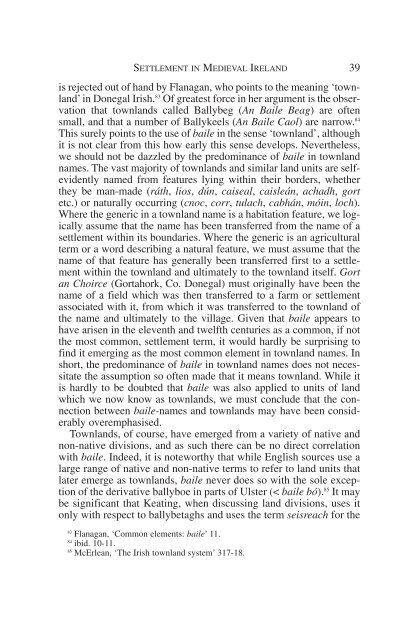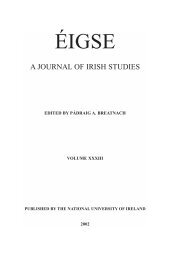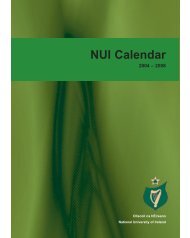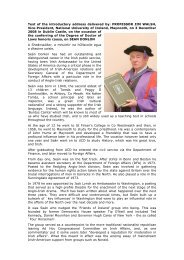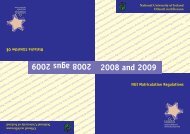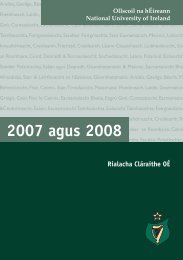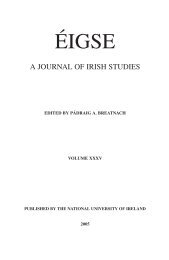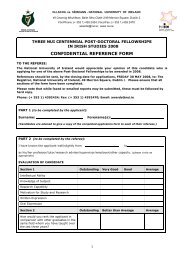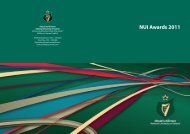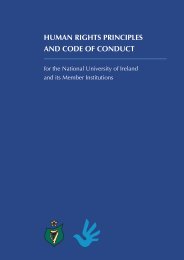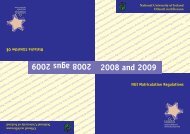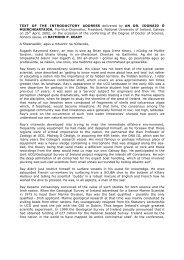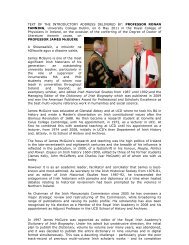Eigse Paged 2004 - National University of Ireland
Eigse Paged 2004 - National University of Ireland
Eigse Paged 2004 - National University of Ireland
You also want an ePaper? Increase the reach of your titles
YUMPU automatically turns print PDFs into web optimized ePapers that Google loves.
SETTLEMENT IN MEDIEVAL IRELAND 39<br />
is rejected out <strong>of</strong> hand by Flanagan, who points to the meaning ‘townland’<br />
in Donegal Irish. 83 Of greatest force in her argument is the observation<br />
that townlands called Ballybeg (An Baile Beag) are <strong>of</strong>ten<br />
small, and that a number <strong>of</strong> Ballykeels (An Baile Caol) are narrow. 84<br />
This surely points to the use <strong>of</strong> baile in the sense ‘townland’, although<br />
it is not clear from this how early this sense develops. Nevertheless,<br />
we should not be dazzled by the predominance <strong>of</strong> baile in townland<br />
names. The vast majority <strong>of</strong> townlands and similar land units are selfevidently<br />
named from features lying within their borders, whether<br />
they be man-made (ráth, lios, dún, caiseal, caisleán, achadh, gort<br />
etc.) or naturally occurring (cnoc, corr, tulach, cabhán, móin, loch).<br />
Where the generic in a townland name is a habitation feature, we logically<br />
assume that the name has been transferred from the name <strong>of</strong> a<br />
settlement within its boundaries. Where the generic is an agricultural<br />
term or a word describing a natural feature, we must assume that the<br />
name <strong>of</strong> that feature has generally been transferred first to a settlement<br />
within the townland and ultimately to the townland itself. Gort<br />
an Choirce (Gortahork, Co. Donegal) must originally have been the<br />
name <strong>of</strong> a field which was then transferred to a farm or settlement<br />
associated with it, from which it was transferred to the townland <strong>of</strong><br />
the name and ultimately to the village. Given that baile appears to<br />
have arisen in the eleventh and twelfth centuries as a common, if not<br />
the most common, settlement term, it would hardly be surprising to<br />
find it emerging as the most common element in townland names. In<br />
short, the predominance <strong>of</strong> baile in townland names does not necessitate<br />
the assumption so <strong>of</strong>ten made that it means townland. While it<br />
is hardly to be doubted that baile was also applied to units <strong>of</strong> land<br />
which we now know as townlands, we must conclude that the connection<br />
between baile-names and townlands may have been considerably<br />
overemphasised.<br />
Townlands, <strong>of</strong> course, have emerged from a variety <strong>of</strong> native and<br />
non-native divisions, and as such there can be no direct correlation<br />
with baile. Indeed, it is noteworthy that while English sources use a<br />
large range <strong>of</strong> native and non-native terms to refer to land units that<br />
later emerge as townlands, baile never does so with the sole exception<br />
<strong>of</strong> the derivative ballyboe in parts <strong>of</strong> Ulster (< baile bó). 85 It may<br />
be significant that Keating, when discussing land divisions, uses it<br />
only with respect to ballybetaghs and uses the term seisreach for the<br />
83<br />
Flanagan, ‘Common elements: baile’11.<br />
84<br />
ibid. 10-11.<br />
85<br />
McErlean, ‘The Irish townland system’ 317-18.


